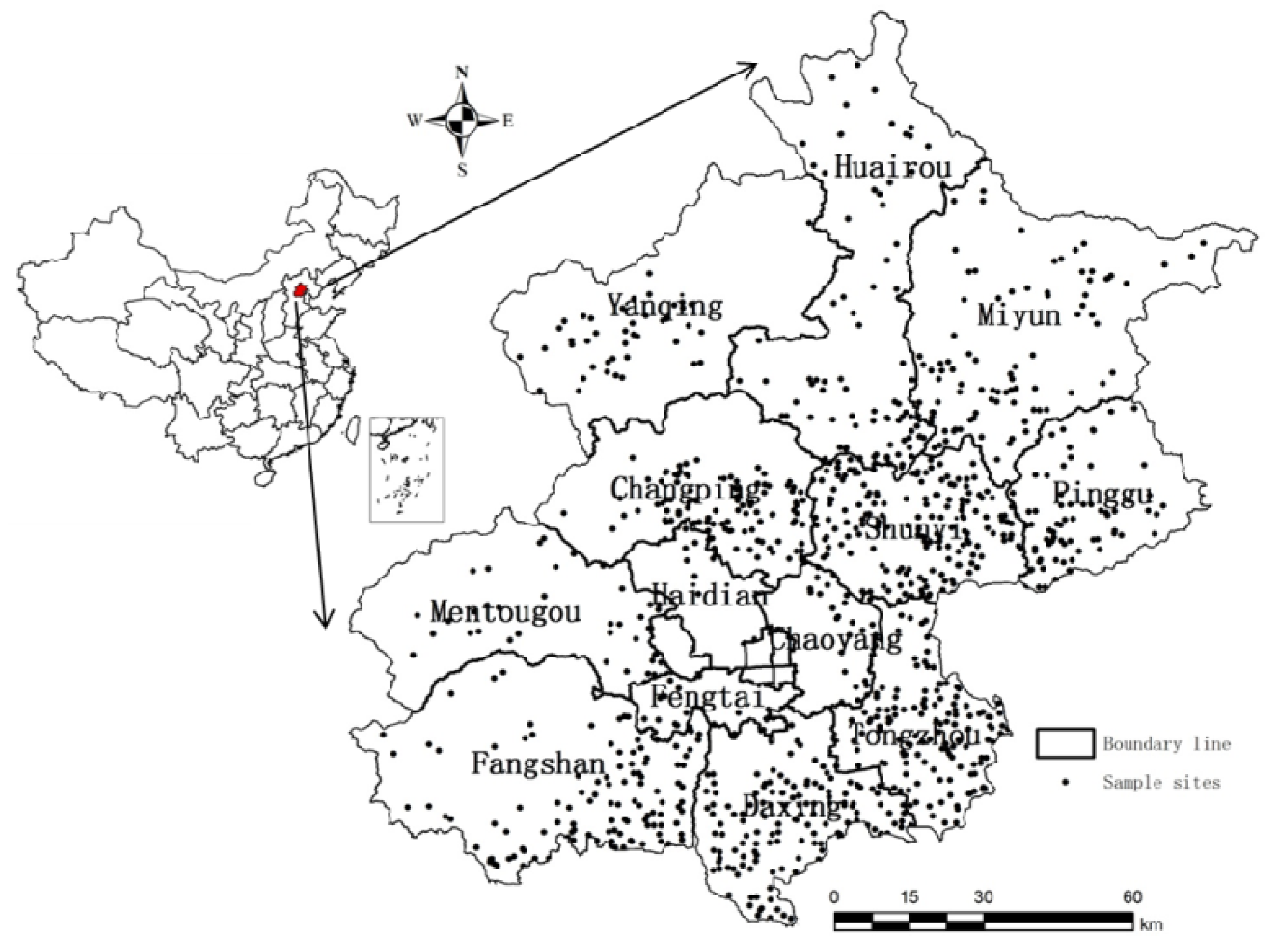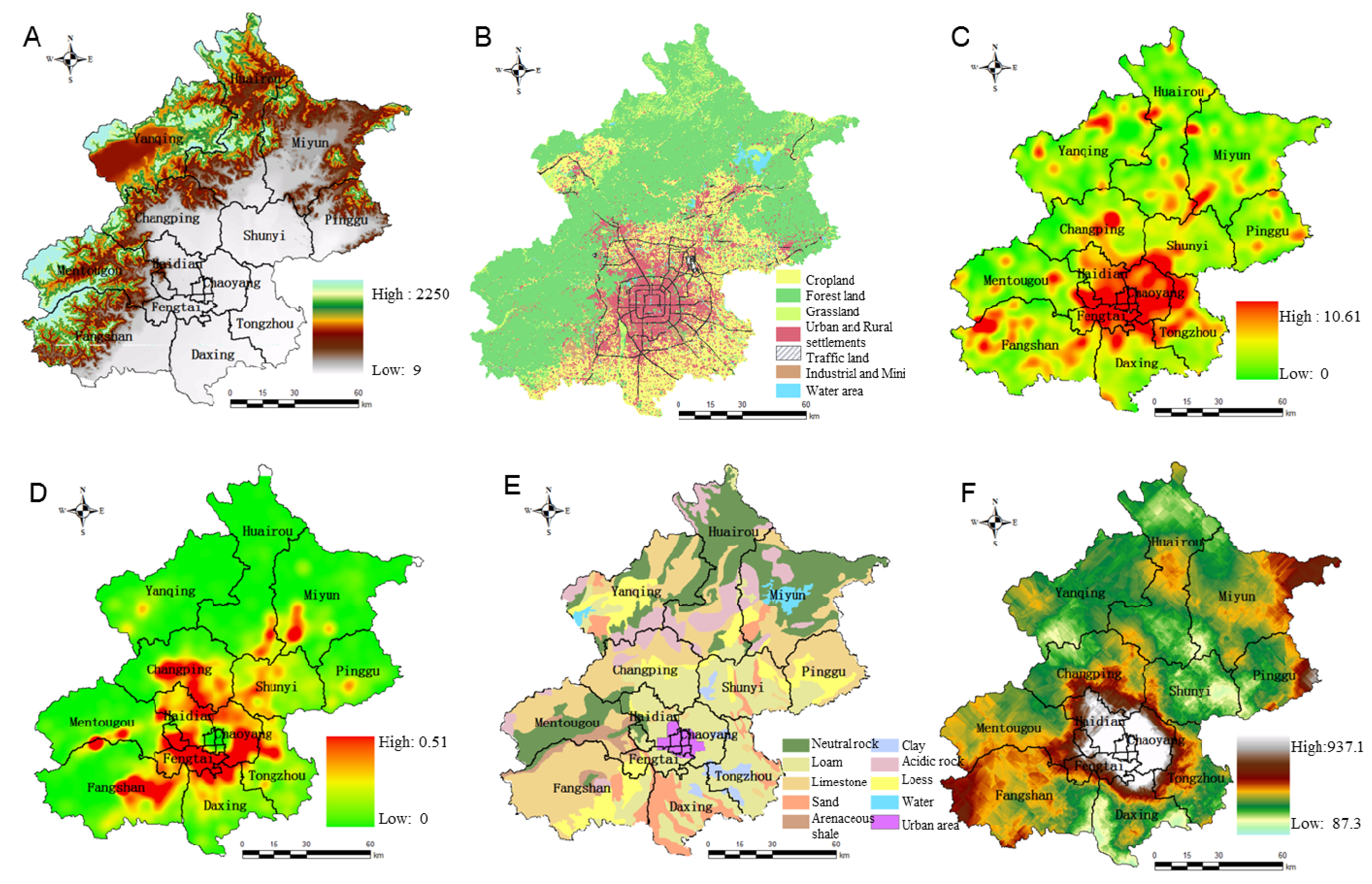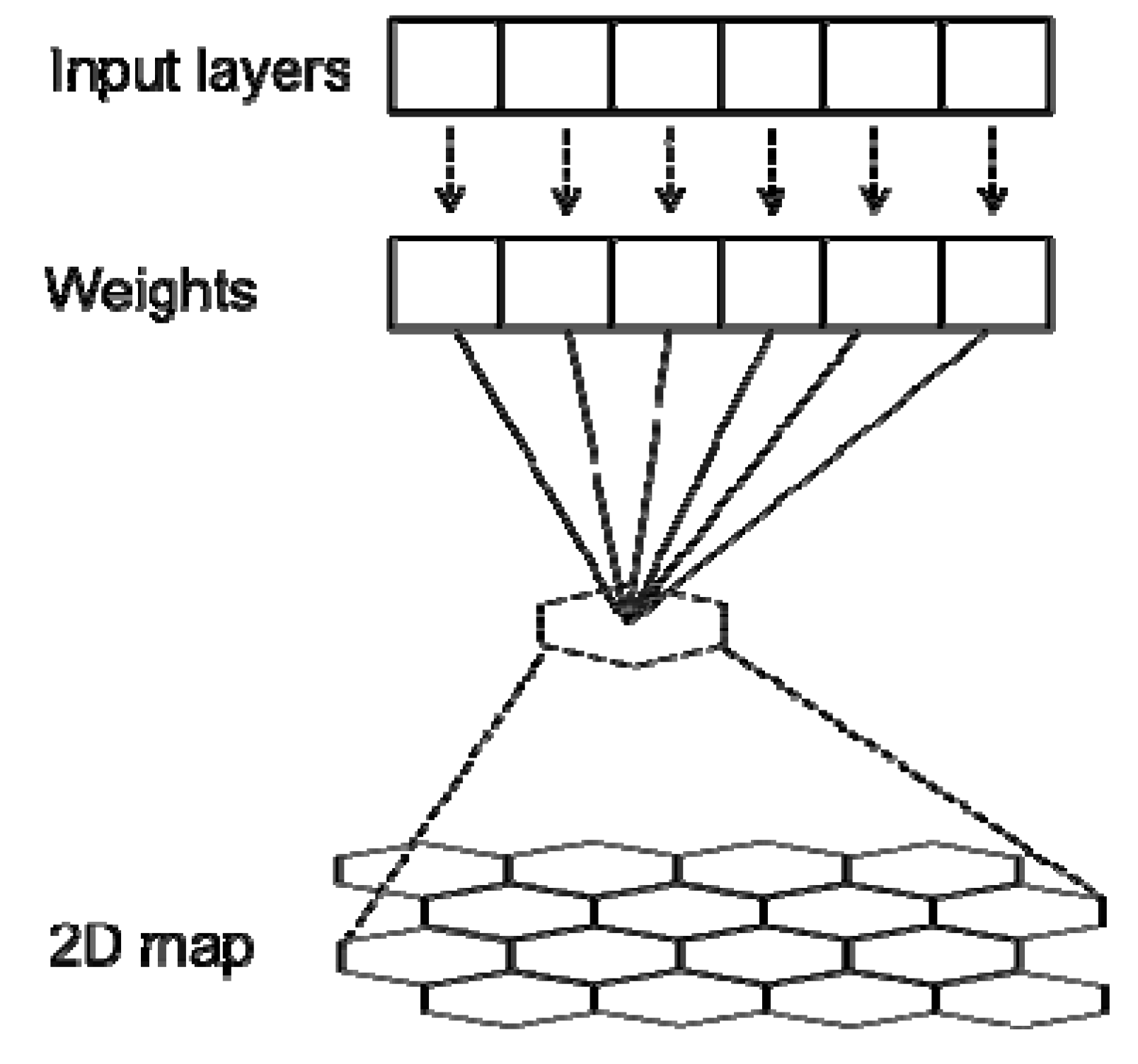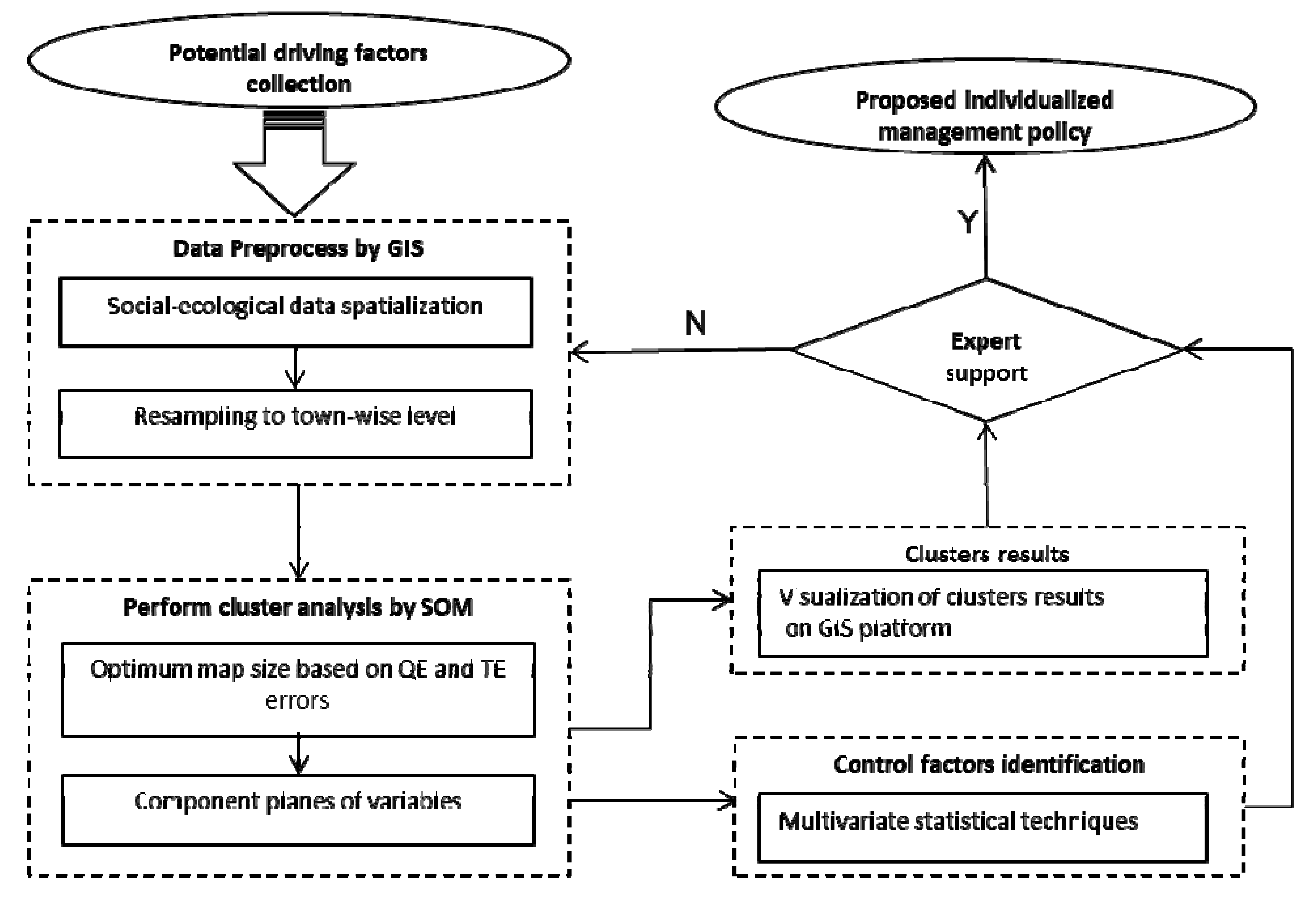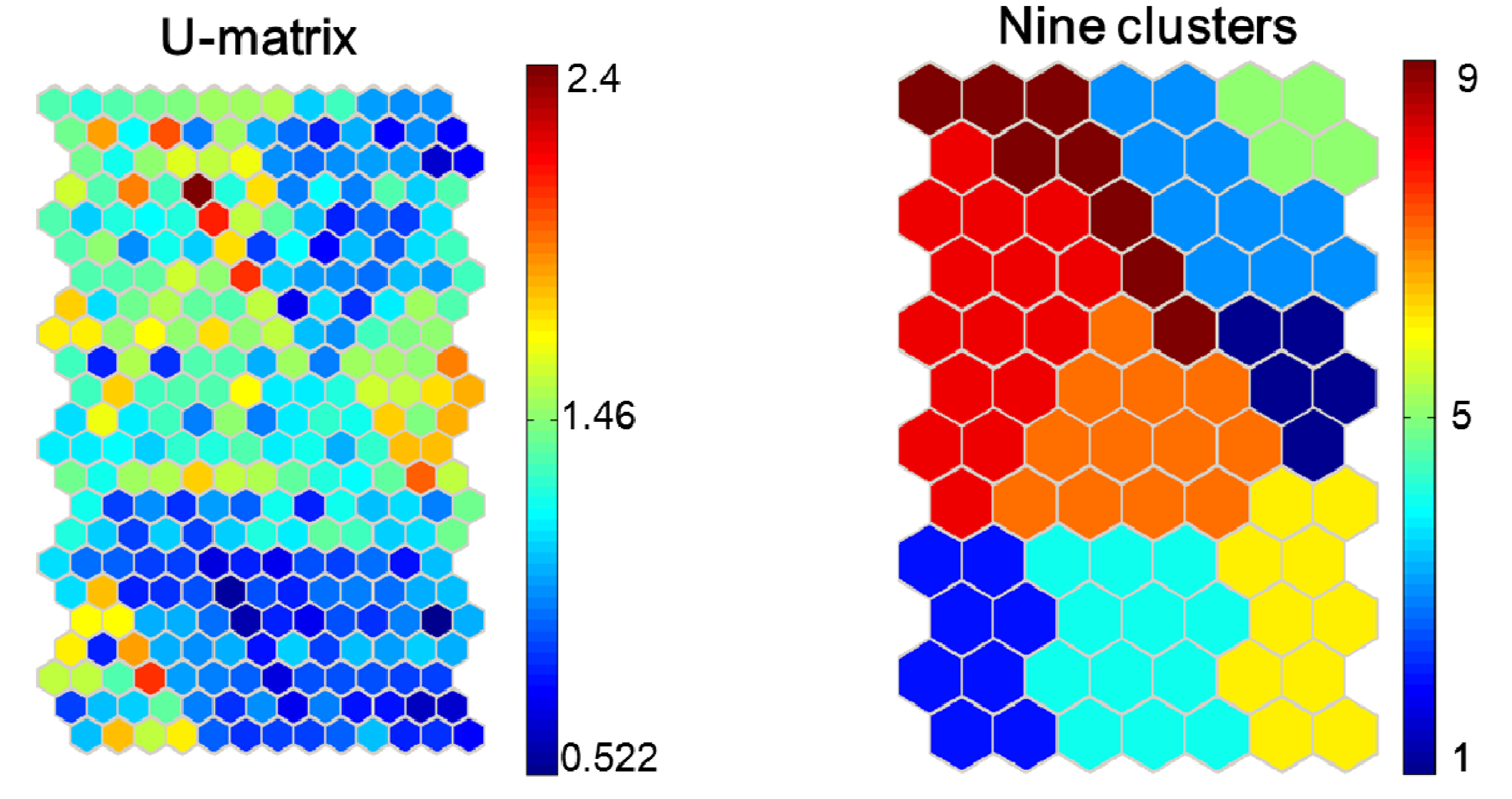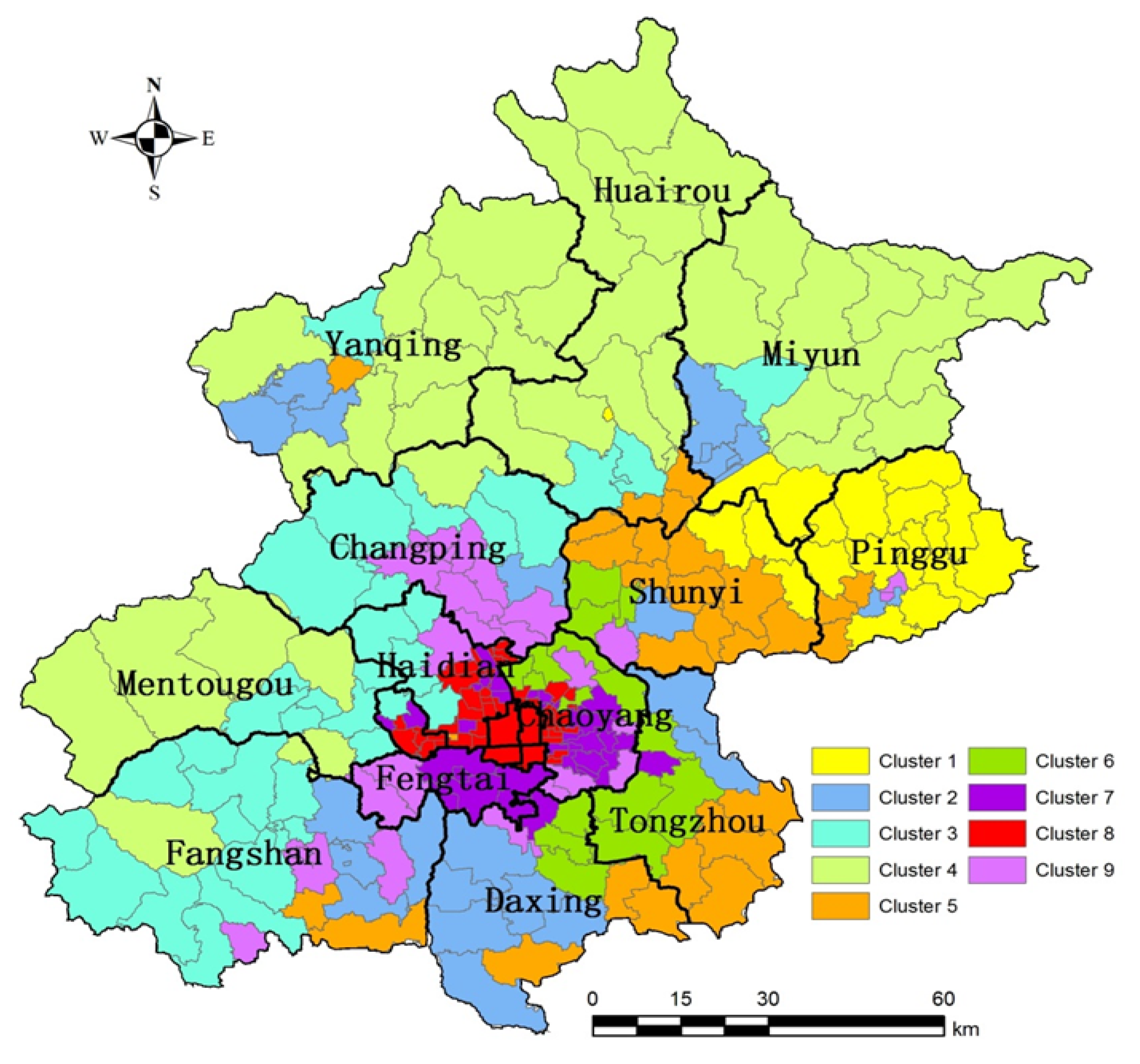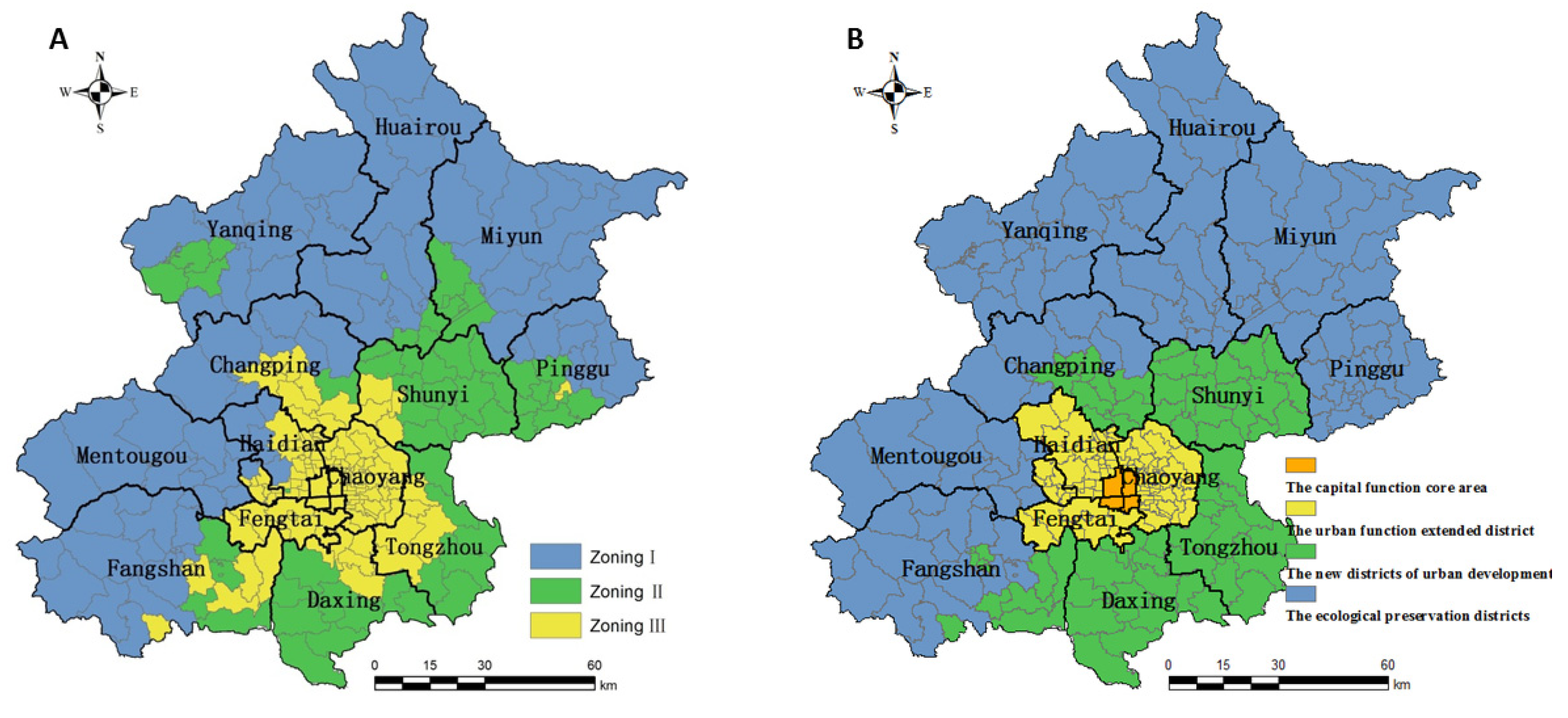1. Introduction
Accumulation of heavy metals in agricultural soils may cause serious problems to human well-being by influencing soil quality, groundwater and food chains [
1,
2,
3,
4,
5]. For the last two decades, instead of natural factors, anthropogenic activity has significantly increased the circulation of toxic metals through soil, water and air. In China, a growing public concern has been focused on the trace elements environment owing to the rapid industrialization, urbanization and increasing reliance on agrochemicals in the last two decades [
6,
7,
8]. Thus the complex system management of trace elements requires understanding the interaction between the natural system and human socio-economic activities (social-ecological patterns), not only to monitor the distribution status, but also to identify the patterns and processes in different ecoregions or ecosystems. Each ecoregion may respond relatively homogeneously to human activity or management actions [
9,
10,
11,
12,
13,
14].
Identifying and quantifying the social-ecological patterns of heavy metals (SEPHM) is a challenging task to due to the variety and complexity of social-ecological data [
7,
10,
15,
16,
17,
18]. Conventional multivariate methods are somewhat limited for interpreting the non-linear and complex dynamic nature. Agent models from biologically inspired machine intelligence have been proposed recently for analyzing and processing complex data to understand the ecological and physiological functioning of life systems [
12,
19,
20], including artificial neural networks, genetic algorithms, support vector machines, individual-based models, cellular automata, fuzzy models,
etc. [
12,
21,
22] . Extensive information and examples can be found in Recknagel [
23].
SOM is a very interesting and promising classification approach employing an innovative and data-driven classification method based on unsupervised artificial neural networks. Its capabilities of clustering, classification, estimation, and prediction have been used in a widely spread range of disciplines, including engineering, agriculture, health, environment management, and remote sensing image classification,
etc. The SOM component planes can reveal very useful information to interpret results that remain hidden with the traditional approaches, such as the principal component analysis and hierarchical cluster analysis [
24,
25,
26].
The heavy metal contamination of Beijing soils has been widely reported. Huo
et al. [
4] assessed the spatial variability of heavy metals with a total of 1,018 samples covering the entire Beijing agricultural soils area using Geostatistics, furthermore, combining Geostatistics with Moran’s I analysis to produce high quality heavy metals interpolation maps [
27,
28]. Jiang
et al. [
5] and Wang
et al. [
29] assessed the potential eco-risk of heavy metals in agricultural and urban soils, respectively. Many investigations have been done on the heavy metal pollution in different land uses of Beijing [
29,
30,
31,
32,
33,
34,
35]. Li
et al. [
36] attempted to quantify the spatial linkages of the heavy metals in Beijing agricultural soil using complex network theory in order to identify their diffusion evolutionary mechanisms. However, there is still a notable lack of the social-ecological patterns study to elucidate the underlying processes between the natural system and human socio-economic activities with heavy metals and the remediation methods and policies.
Therefore, the objectives of this study were to explore the potential of the SOM approach to identify the SEPHM in Beijing, and to propose individualized approaches to the management of the soil heavy metal pollution.
2. Study Sites
Beijing, with an estimated area of 16.4 thousand km
2, is located in the northwestern part of China’s north plain, generally between longitude 115°24'–117°30'E and latitude 39°38'–41°05'N. Its elevation slopes downward from 2,250 m in the northwest to 10 m in the southeast, and the mountainous area covers about 62% and plain 38% of the whole area (
Figure 1).
Figure 1.
Distribution of sample sites in the study area.
Figure 1.
Distribution of sample sites in the study area.
The area has a temperate continental monsoonal climate with an annual average temperature of 11.8° (average maximum 26° in July and average minimum −5° in January). The annual average temperature difference is 30.4°, while the daily average temperature difference is 11.4°. Annual precipitation in this area is 470–660 mm, about 60% of which comes in July and August. Annual average evaporation is 1,800–2,000 mm. The area is the source of five big rivers, the Yongding, Chaobai, Beiyun, Jiyun and Daqing. Annual average runoff is about 1.8 × 10
9 m
3, but had decreased to 1.3 × 10
9 m
3 by the end of the last century. The main soil types include drab soil, brown soil and skeleton soil in mountainous areas, and fluvo-aquic soil in plain areas. The population of the study areas was about 20.69 million, and the vehicle population reached 5.4 million in 2012. Heavy metals management is an important and complicated factor in the development of an ecological environment strategy in Beijing, because its environmental problems might represent the future of the other metropolis in China [
37].
5. Discussion
Ecology is not able to quantify all the relations between exposure and effects of contaminants such as heavy metals, because of the complexity of the sources and their interactions with human well-being. Thus, ecologists and environmental managers endeavor to find environmental indicators which can represent parts of these complex environmental relationships. In recent decades, there have been a series of classifications of different subjects, such as aquatic ecosystem classifications (AEC), biodiversity conservation classification and forest service classification. Social-ecological patterns represent the comprehensive interaction of substance and energy, which form the live organisms and the environment. Thus, difference-oriented policies should be made based on the local ecosystems, which share a number of basic structural and functional characteristics [
10,
13]. In this study, SOM was performed to classify the region of Beijing into nine clusters at the town-wise level, and a number of the major factors that control heavy metals contamination were identified in each cluster.
SOM have been proven to be a promising tool for describing the evolution of metal accumulations in terrestrial ecosystems. The SOM projection shifts the complicated structure from high dimensional arrays into the lower dimensional clusters based on the neighborhood relations, which is important to ecological classifications for environmental management. For instance, the spatial generalization of environmental data are measured at single sites as well as in dynamic global change modeling in land use or environmental planning [
11,
60,
61]. Land classifications provide spatial reference systems that may indicate long-term effects (responses), for example, structural and functional, resulting from the bioaccumulation of contaminants. Such effects depend both on the stress intensity and on the ecological characteristics and related sensitivities of the land unit which is exposed [
10].
From the results of this study, it can be concluded that the heavy metals contamination patterns are strongly related to human populations, IML, and ROD distribution. Additionally, vegetation and geographical aspects of the land also affected heavy metals concentration. We could hypothesize the sequential pattern as the following: (1) high heavy metals risk areas locate in urbanized areas that exhibit high population and low elevation, which are suitable for increased road and IML density; (2) these areas, are more frequently invaded by vehicular traffic volumes and urbanization; (3) therefore, land use management on community units (at a town level) is needed in the more populated areas in order to reduce the heavy metals risk.
Results from the ANOVA analysis of the element contents show differences among the clusters indicating that heavy element contents in clusters 7, 8 and 9 (the urban area) were higher than the other clusters. Cu, Zn, Cd, Pb and Hg in urban soils usually come from gasoline, car components, oil lubricants, and industrial and incinerator emissions [
6,
34,
62,
63,
64]. Although leaded gasoline has been banned in Beijing since 1997, the impact on this area may last for the coming years [
6], and also decoration waste deposition from the repairs of time-honored parks was considered [
29]. The source of Cd in this area may be from coal combustion, solid wastes such as plastics and automobile tires [
29,
34]. The casting of bronze ritual figures and the automobile tire wear were considered to be the main sources of Cu and Zn. Hg mainly came from the atmospheric deposition along the roadside. Therefore, traffic volume regulations and air cleaning plans should be implemented in these areas. Clusters 2, 5 and 6 are mainly located in the agricultural areas and are far away from the central city, while Cr, Cu, Zn, Hg exhibited ascending trends among them. These may illustrate that the sources were both from industrial emissions and agrochemical inputs [
8,
31,
33]. Therefore, green agriculture is suitable in these communities, which should decrease the use of the Cd-containing, Cu-containing agricultural material inputs from agricultural activities. Heavy metals in clusters 1, 3 and 4 showed higher level elevation, vegetation index, precipitation and parent materials diversity than other clusters. Restoration management was needed in these areas, which was consistent with the report of the Beijing Government [
65].
To meet the land-use management needs, besides the identification of metal accumulation spatial patterns, the consecutive spatial patterns are also an important component of zoning [
66]. Integrating the fragmentary zones benefits soil trace elements management at the generalized scale. According to the analysis in
Section 4.2, in the present study, the main soil heavy metals contamination patterns could be drawn in three zones.
Figure 8A illustrates the spatial distribution of communities in Beijing in accordance with clustering results analysis and SOM model.
Figure 8.
(A) Further presentation of clustering results and (B) Major function oriented zone of Beijing.
Figure 8.
(A) Further presentation of clustering results and (B) Major function oriented zone of Beijing.
Zone I was located in the mostly mountainous areas and had relatively high vegetation cover in the west and northwest of Beijing (
Figure 2A,B). Zone II consisted of the communities located in the peripheral suburbs, whose predominant land use type was agricultural land (
Figure 2B). Furthermore, Yanqing was also detected and grouped into zone II, where was used to be a large state farm. Zone III Ⅲ was formed with the remaining area, and located inside the 6th ring, and this contains the most recently urbanized area of Beijing (
Figure 2B–D). Regarding the clusters, clusters 1, 3 and 4 were mainly contained in zone I, clusters 2, 5, and 6 were attached to zone II, and the remainder were located in zone III. In order to prove the cluster results we proposed, the current development plan of Beijing was employed for analysis.
In China, the concept of major function oriented zone (MOFZ) was proposed to achieve coordinated regional development and environmental protection based on the territorial functions [
67,
68]. More recently, the MOFZ of Beijing municipality was released [
69] and it clearly stated four function-oriented zones (the capital function core area, the urban function extended district, the new districts of urban development and the ecological preservation districts, see
Figure 8B). However, the four districts may not be satisfactory for concrete environmental management policy formulations. The nine zones proposed in the present study were clustered by a bottom-up approach based on SOM. Although the MOFZ was made by political or legal means, the integrated zones in accordance with the SOM and multivariate statistical techniques were consistent with the MOFZ of Beijing, indicating that the classification in this literature was reasonable and suited for the actual conditions of the study area. However, a slight difference could be found between
Figure 8A,B. The former zones were not limited by the administrative boundary lines. For example, the propagation pathway of zone III was similar to the new districts of urban development in the downwind southeast quadrant of the city. Moreover, the direction of expansion of the Changping and Fangshan districts should be considered by government decision makers.
